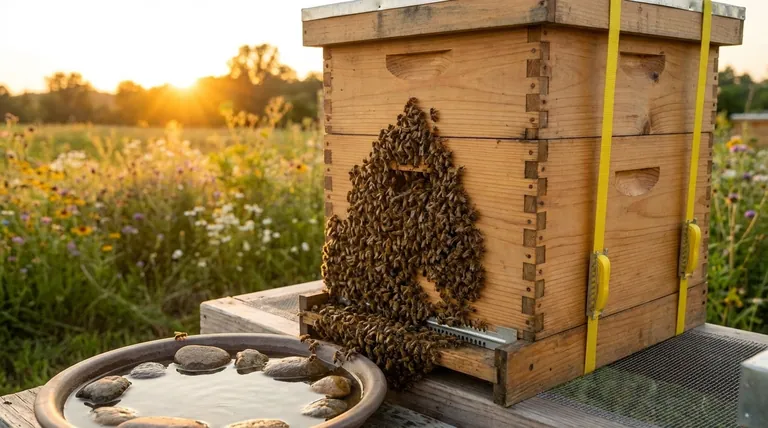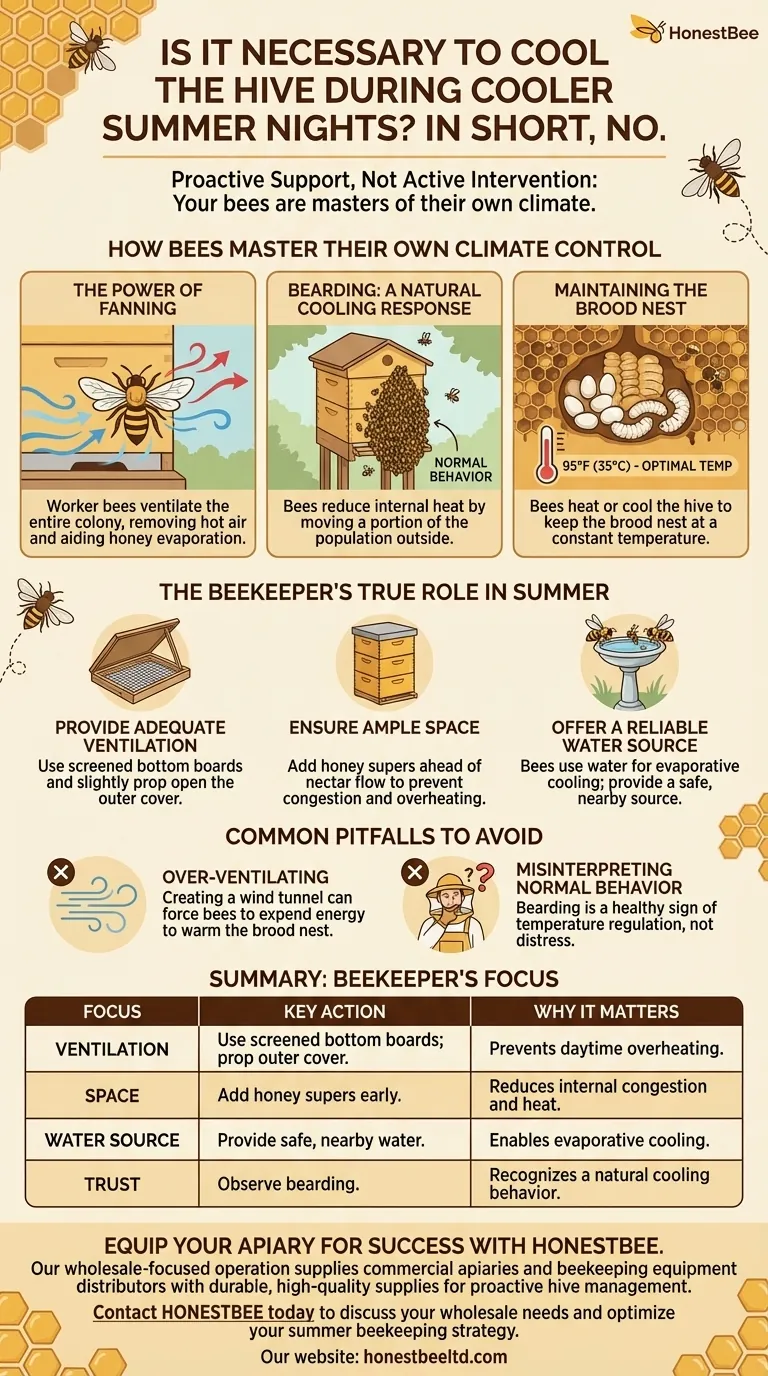In short, no. It is not necessary to actively cool your beehive during cooler summer nights. Honeybees are exceptionally skilled at thermoregulation and have evolved sophisticated methods to maintain a stable internal hive environment, even as external temperatures fluctuate.
The core principle of summer hive management is not active intervention, but proactive support. Your focus should be on providing the bees with the space, ventilation, and resources they need to manage their own temperature, rather than trying to manage it for them.

How Bees Master Their Own Climate Control
Understanding the bees' own capabilities is key to knowing when—and when not—to intervene. They are not passive occupants; they are active architects of their environment.
The Power of Fanning
Worker bees will station themselves at the hive entrance and throughout the hive, fanning their wings in unison. This creates a current of air that ventilates the entire colony, removing hot, stale air and pulling in cooler, fresh air.
This fanning also plays a critical role in honey production by helping to evaporate water from the stored nectar.
Bearding: A Natural Cooling Response
On hot days and warm evenings, you may see a large cluster of bees hanging on the outside of the hive. This behavior, known as bearding, is a completely normal cooling strategy.
By moving a portion of the population outside, the bees reduce the internal heat and congestion within the hive, making it easier to regulate the temperature for the critical brood nest.
Maintaining the Brood Nest
The bees' primary thermal goal is to keep the brood nest—where the queen lays eggs and larvae develop—at a constant temperature of around 95°F (35°C). They will heat or cool the hive as needed, day or night, to maintain this precise temperature for optimal brood health.
The Beekeeper's True Role in Summer
Instead of worrying about nighttime temperatures, your efforts should be directed toward addressing the two real challenges of summer: intense daytime heat and the honey flow.
Provide Adequate Ventilation
Ensure the hive has a way to breathe. A screened bottom board provides excellent passive ventilation. You can also slightly prop open the outer cover with a small shim or stick to allow hot air to escape from the top.
Ensure Ample Space
A crowded hive is a hot hive. As the colony expands and brings in nectar, they need room. Adding honey supers ahead of the main nectar flow gives the bees space to work and store honey, preventing congestion that contributes to overheating.
Offer a Reliable Water Source
Bees use water for evaporative cooling inside the hive, similar to an air conditioner. Providing a nearby, safe water source (like a birdbath with rocks for landing) reduces foraging stress and gives them a key tool for temperature control.
Common Pitfalls to Avoid
Well-intentioned actions can sometimes hinder the colony. The goal is to support, not disrupt, their natural processes.
The Risk of Over-Ventilating
While ventilation is crucial, creating a wind tunnel through the hive can be counterproductive. Excessive drafts, especially on cooler nights, can force the bees to expend extra energy and resources just to keep the brood nest warm.
Misinterpreting Normal Behavior
Seeing a large beard of bees for the first time can be alarming, leading new beekeepers to think the hive is about to swarm or is in distress. Resist the urge to intervene. This is a healthy sign that the colony is successfully managing its temperature.
How to Apply This to Your Hive
Your summer management strategy should be simple and proactive.
- If your primary focus is colony health: Trust your bees' ability to manage nighttime temperatures and concentrate on providing excellent daytime ventilation and a consistent water source.
- If your primary focus is maximizing honey production: Ensure the colony always has adequate space by adding supers before they need them, which prevents the crowding that leads to overheating and reduced productivity.
Ultimately, your role is to provide the right conditions, then step back and let the bees do what they have done perfectly for millions of years.
Summary Table:
| Beekeeper's Focus | Key Action | Why It Matters |
|---|---|---|
| Ventilation | Use screened bottom boards; prop open outer cover. | Allows hot air to escape, prevents daytime overheating. |
| Space | Add honey supers before the nectar flow. | Reduces internal congestion and heat buildup. |
| Water Source | Provide a safe, nearby water supply. | Enables bees to use evaporative cooling inside the hive. |
| Trust | Observe bearding without intervention. | Recognizes a natural, healthy cooling behavior. |
Equip your apiary for success with HONESTBEE.
Our wholesale-focused operation supplies commercial apiaries and beekeeping equipment distributors with the durable, high-quality supplies needed for proactive hive management—like screened bottom boards and honey supers. Let us help you support your bees' natural instincts for a healthier, more productive colony.
Contact HONESTBEE today to discuss your wholesale needs and optimize your summer beekeeping strategy.
Visual Guide

Related Products
- Professional Galvanized Hive Strap with Secure Locking Buckle for Beekeeping
- Professional Grade Foldable Beehive Handles
- Professional Drop-Style Hive Handles for Beekeeping
- Black Plastic Beetle Barn Hive Beetle Trap for Beehives
- Langstroth Screen Bottom Board for Beekeeping Wholesale
People Also Ask
- How can beekeepers secure the top cover of a hive? Protect Your Colony from Wind and Weather
- What are the types of Emlocks available? Choose the Right Strap for Hive Security
- What is the advantage of using cam buckle straps? Secure Your Load Fast with Simple, Safe Tensioning
- What is the best length for straps used around beehives? Why 12 Feet is the Industry Standard
- What are the two styles of hive straps? Choose the Right Strap for Your Hive Security



















